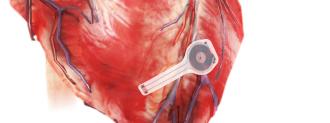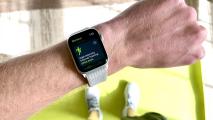Scientists at Northwestern and George Washington University have developed a pacemaker that completely dissolves over the course of five to seven weeks.
“Hardware placed in or near the heart creates risks for infection and other complications,” John Rogers, who led the development of the disappearing pacemaker, said in Northwestern’s release.
“This unusual type of device could represent the future of temporary pacing technology.”
A temporary change of pace: A pacemaker uses electrical impulses to correct a patient’s irregular heartbeat. Sitting inside the chest, they require surgery to place — or remove.
“Sometimes patients only need pacemakers temporarily, perhaps after an open heart surgery, heart attack or drug overdose,” Northwestern Medicine cardiologist Rishi Arora, who co-led the study, said in the release. “After the patient’s heart is stabilized, we can remove the pacemaker.”
The pacemaker completely dissolves over five to seven weeks.
Currently, a temporary pacemaker requires inserting a wire from the device to a pack outside of the skin. In place for up to a week, these wires have the potential to become infected or knocked loose; implanted devices, such as pacemakers, account for over half of healthcare-associated infections.
Other complications could include torn or damaged tissues — possibly exacerbated by scarring around the leads — bleeding, and blood clots.
Testing your dissolve: The dissolvable pacemaker, published in Nature Biotechnology, skirts these problems; since it has no leads or battery, it can completely dissolve away.
“The circuitry is implanted directly on the surface of the heart, and we can activate it remotely,” Arora said.
The pacemaker draws its power wirelessly, from a remote antenna using near-field communication (NFC) protocols — the same technology you use to pay for things with your smartphone. All in, the pacemaker weighs less than a gram, is only 250 microns thick, and is pliable.
“This unusual type of device could represent the future of temporary pacing technology.”
John Rogers
“The device relies exclusively on materials that resorb when exposed to biofluids in a time-controlled manner,” the authors wrote in their paper. By harnessing the body’s own metabolic processes and hydrolysis (water’s ability to chemically break down compounds) the pacemaker dissolves into the body.
Multiple animal models were used to test the pacemaker, including rat, mouse, rabbit, and dogs, as well as in human heart slices in the lab.
The in vivo testing of the pacemaker in dogs “suggest the feasibility of this pacemaker system for adult human patients,” the team wrote.
Transient fix, permanent solution? Rogers has built transient devices before. According to Northwestern, Rogers was part of the team that debuted the first “bioresorbable” electronic device, an implant that stimulates nerve regeneration.
With two proof-of-concept devices now completed, Rogers believes these dissolvable implants may become a more common tool in the future.
“We can tailor the devices to address a broad spectrum of relevant lifetimes,” Rogers said.
“Transient technologies, in general, could someday provide therapy or treatment for a wide variety of medical conditions — serving, in a sense, as an engineering form of medicine.”
We’d love to hear from you! If you have a comment about this article or if you have a tip for a future Freethink story, please email us at [email protected].






